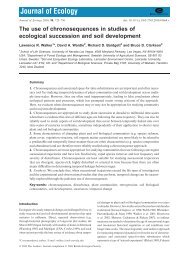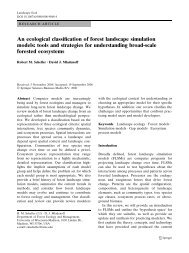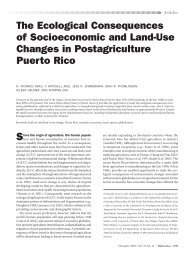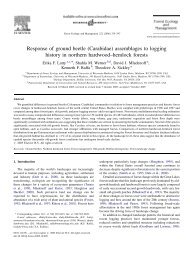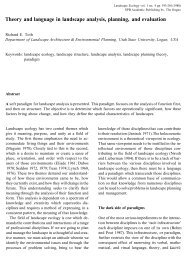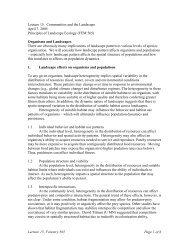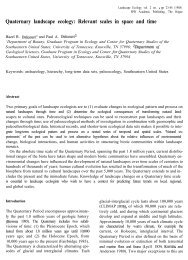Improving the formulation of tree growth and succession in a ...
Improving the formulation of tree growth and succession in a ...
Improving the formulation of tree growth and succession in a ...
You also want an ePaper? Increase the reach of your titles
YUMPU automatically turns print PDFs into web optimized ePapers that Google loves.
S. Schumacher et al. / Ecological Modell<strong>in</strong>g 180 (2004) 175–194 177<br />
lifespans, even if <strong>the</strong>y were assigned very low establishment<br />
probabilities. Under <strong>the</strong> current weak disturbance<br />
regime <strong>of</strong> <strong>the</strong> central European Alps, LANDIS<br />
produced a strong dom<strong>in</strong>ance <strong>of</strong> subalp<strong>in</strong>e (1600–2300<br />
m a.s.l.) l<strong>and</strong>scapes by P<strong>in</strong>us cembra <strong>in</strong>stead <strong>of</strong> <strong>the</strong><br />
widespread Picea abies (cf. Ellenberg, 1996). In reality,<br />
P. cembra may reach old age, but is not normally competitive<br />
aga<strong>in</strong>st P. abies except at <strong>the</strong> highest elevations<br />
<strong>and</strong> <strong>in</strong> dry cont<strong>in</strong>ental climates. We had to conclude that<br />
<strong>the</strong> forest st<strong>and</strong> description <strong>and</strong> st<strong>and</strong>-scale ecological<br />
processes <strong>in</strong>cluded <strong>in</strong> <strong>the</strong> model were too simplistic to<br />
realistically simulate forest dynamics <strong>in</strong> weakly disturbed<br />
l<strong>and</strong>scapes, thus mak<strong>in</strong>g it impossible to study<br />
<strong>the</strong>ir fate under a chang<strong>in</strong>g disturbance regime.<br />
In addition, <strong>the</strong> establishment probabilities <strong>in</strong> LAN-<br />
DIS have to be def<strong>in</strong>ed by <strong>the</strong> user, i.e. <strong>the</strong>y do not<br />
emerge from <strong>the</strong> <strong>in</strong>teractions <strong>of</strong> <strong>the</strong> modeled processes.<br />
This does not allow <strong>the</strong> user to simulate <strong>the</strong> effects <strong>of</strong><br />
a chang<strong>in</strong>g environment (e.g. climate change) on l<strong>and</strong>scape<br />
properties, or to simulate transitions <strong>of</strong> species<br />
composition over a climatic gradient without basically<br />
prescrib<strong>in</strong>g <strong>the</strong> outcome <strong>of</strong> such changes via modified<br />
parameter values. Thus, establishment probabilities<br />
have a decisive effect with regard to determ<strong>in</strong><strong>in</strong>g<br />
species composition across <strong>the</strong> l<strong>and</strong>scape.<br />
F<strong>in</strong>ally, LANDIS <strong>in</strong>corporates only presence/<br />
absence data <strong>of</strong> <strong>tree</strong> age-classes, <strong>and</strong> thus does not provide<br />
any quantitative detail about st<strong>and</strong> composition or<br />
st<strong>and</strong> structure at <strong>the</strong> level <strong>of</strong> <strong>the</strong> <strong>in</strong>dividual grid cell.<br />
Therefore, based on <strong>the</strong>se simple variables it is difficult<br />
to model <strong>succession</strong> (i.e., processes such as competition<br />
between <strong>tree</strong>s) more accurately, or to use LANDIS<br />
to assess <strong>the</strong> effects <strong>of</strong> l<strong>and</strong>scape properties on, for example,<br />
ecologically relevant variables such as habitat<br />
suitability for wildlife.<br />
To overcome <strong>the</strong>se shortcom<strong>in</strong>gs, we replaced <strong>the</strong><br />
st<strong>and</strong>-level model parts <strong>of</strong> LANDIS with an improved<br />
<strong>tree</strong> <strong>growth</strong> <strong>and</strong> <strong>succession</strong> sub-model. This sub-model<br />
conta<strong>in</strong>s (1) a more detailed quantitative description <strong>of</strong><br />
forest structure <strong>in</strong> each simulated grid cell, <strong>and</strong> (2) more<br />
mechanistic <strong>formulation</strong>s <strong>of</strong> <strong>growth</strong> <strong>and</strong> competition<br />
than currently <strong>in</strong>corporated <strong>in</strong> l<strong>and</strong>scape models. Tree<strong>and</strong><br />
st<strong>and</strong>-scale ecological processes <strong>in</strong> <strong>the</strong> new model<br />
are mostly derived from approaches <strong>in</strong> <strong>the</strong> widely used<br />
gap models (e.g. Shugart, 1984; Urban <strong>and</strong> Shugart,<br />
1992; Liu <strong>and</strong> Ashton, 1995; Bugmann et al., 1996),<br />
but <strong>the</strong>y were simplified considerably compared to <strong>the</strong>ir<br />
orig<strong>in</strong>al implementation.<br />
We <strong>in</strong>troduced <strong>the</strong>se model modifications with <strong>the</strong><br />
follow<strong>in</strong>g three objectives: (1) to be able to <strong>in</strong>vestigate<br />
<strong>the</strong> <strong>in</strong>fluence <strong>of</strong> a chang<strong>in</strong>g disturbance regime on<br />
l<strong>and</strong>scape properties, i.e. to study <strong>the</strong> transition from<br />
currently weakly disturbed to more strongly disturbed<br />
l<strong>and</strong>scapes <strong>in</strong> <strong>the</strong> future; (2) to be able to study <strong>the</strong><br />
impacts <strong>of</strong> chang<strong>in</strong>g climatic parameters on l<strong>and</strong>scape<br />
dynamics without hav<strong>in</strong>g to make a priori assumptions<br />
about <strong>the</strong>se effects, i.e. to obta<strong>in</strong> a l<strong>and</strong>scape-level<br />
model that is sensitive to climate <strong>and</strong> soil properties,<br />
<strong>and</strong> (3) to <strong>in</strong>vestigate l<strong>and</strong>scape properties that are relevant<br />
for ecosystem management, based on variables relat<strong>in</strong>g<br />
to st<strong>and</strong> biomass, species composition, <strong>and</strong> st<strong>and</strong><br />
structure.<br />
2. Model description<br />
We first give a brief overview <strong>of</strong> <strong>the</strong> orig<strong>in</strong>al LAN-<br />
DIS model, followed by a description <strong>of</strong> <strong>the</strong> exp<strong>and</strong>ed<br />
model that <strong>in</strong>troduces <strong>the</strong> overall model structure <strong>and</strong><br />
describes major model modifications.<br />
2.1. Overview <strong>of</strong> <strong>the</strong> orig<strong>in</strong>al LANDIS model<br />
The LANDIS model has been described <strong>in</strong> detail<br />
elsewhere (He <strong>and</strong> Mladen<strong>of</strong>f, 1999b; He <strong>and</strong><br />
Mladen<strong>of</strong>f, 1999a; He et al., 1999a; He et al., 1999b;<br />
Mladen<strong>of</strong>f <strong>and</strong> He, 1999). It is a spatially explicit,<br />
raster-based, <strong>and</strong> stochastic model designed to simulate<br />
forest change <strong>in</strong> comb<strong>in</strong>ation with disturbance<br />
regimes, such as fire, w<strong>in</strong>dthrow, <strong>and</strong> forest management.<br />
The model simulates vegetation dynamics<br />
on large l<strong>and</strong>scapes (on a scale <strong>of</strong> 10 4 –10 6 ha) <strong>and</strong><br />
over long time spans (e.g. hundreds <strong>of</strong> years) <strong>in</strong> 10-<br />
year time steps. It simulates forest st<strong>and</strong>s on a rectangular<br />
grid with a user-def<strong>in</strong>ed size (usually 30 m<br />
× 30 m). Each grid cell conta<strong>in</strong>s coarse vegetation<br />
<strong>in</strong>formation at <strong>the</strong> species level. Vegetation status is<br />
def<strong>in</strong>ed by <strong>the</strong> presence/absence data <strong>of</strong> 10-year age<br />
cohorts <strong>of</strong> each species. Actual size <strong>and</strong> number <strong>of</strong><br />
<strong>tree</strong>s are not modeled. For each species, a set <strong>of</strong> attributes<br />
such as longevity, age <strong>of</strong> first reproduction,<br />
shade <strong>and</strong> fire tolerance, <strong>and</strong> seed<strong>in</strong>g distance are<br />
driv<strong>in</strong>g vegetation dynamics. Fur<strong>the</strong>rmore, each grid<br />
cell belongs to a so-called “l<strong>and</strong> type”. These userdef<strong>in</strong>ed<br />
l<strong>and</strong> types are <strong>the</strong> basis for dist<strong>in</strong>guish<strong>in</strong>g<br />
between different site characteristics, environmental



